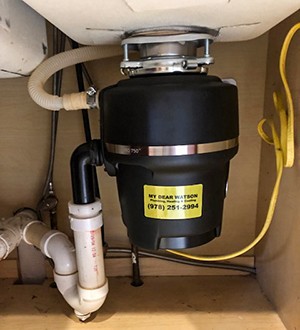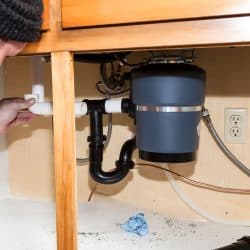Your Definitive Guide to Fixing a Leaky Waste Disposal Unit
Your Definitive Guide to Fixing a Leaky Waste Disposal Unit
Blog Article
Right here below you will discover more professional details regarding Why Is .

Waste disposal unit are important cooking area devices that aid in dealing with food waste efficiently. However, a leaking waste disposal unit can be a discouraging and untidy issue to take care of. Luckily, several leakages can be fixed easily with a few simple actions. In this write-up, we will certainly go over exactly how to take care of a leaking garbage disposal effectively.
Intro
Waste disposal unit are set up under kitchen sinks and are designed to shred food waste right into smaller sized pieces, permitting it to go through the plumbing system conveniently. While these devices are usually trustworthy, leaks can take place in time due to deterioration, loose links, or damage to the system.
Step-by-Step Guide to Taking Care Of a Leaking Waste Disposal Unit
Shut off the Power
Prior to attempting any type of repairs, make sure that the power to the waste disposal unit unit is shut off to stop the risk of electrical shock.
Find the Leakage
Determine the precise location of the leakage and figure out the cause
Tighten up Connections
Utilize a wrench to tighten any type of loose links between the disposal unit and the pipes system.
Replace Seals or Gaskets
If the leakage is due to used seals or gaskets, get rid of the old elements and change them with new ones.
Patching Splits or Holes
For fractures or openings in the disposal unit, usage epoxy or a suitable patching material to seal the damaged location.
Recognizing the Source of the Leak
Prior to trying to repair a dripping waste disposal unit, it is necessary to determine the source of the leak. This can normally be done via visual inspection or by carrying out easy tests.
Visual Assessment
Check the waste disposal unit device carefully for any indicators of water leak. Pay attention to locations around seals, gaskets, and connection points.
Checking for Leaks
One means to evaluate for leaks is by running water via the disposal system and looking for any type of noticeable signs of leak.
Common Sources Of Leaks in Rubbish Disposals
Worn Seals and Gaskets
Seals and gaskets play an important duty in stopping water from dripping out of the garbage disposal. Gradually, these parts can deteriorate, resulting in leakages around the disposal device.
Loose Connections
The connections between the waste disposal unit and the plumbing system can end up being loosened over time, causing water to leakage out during procedure.
Fractures or Holes in the Disposal Unit
Physical damage to the garbage disposal, such as cracks or openings in the real estate, can likewise lead to leakages.
Devices and Materials Needed for Repairing a Leaking Waste Disposal Unit
Prior to starting the fixing procedure, collect the needed devices and materials, including a screwdriver, adjustable wrench, plumbing technician's putty, substitute seals or gaskets, and epoxy or patching product for fixing fractures or holes.
Testing the Waste Disposal Unit After Repair Service
When the repair is full, check the garbage disposal by running water via it to ensure that the leakage has been dealt with.
Preventive Upkeep Tips to Prevent Future Leakages
To avoid future leakages, it is necessary to execute routine maintenance on your waste disposal unit. This includes maintaining it tidy, avoiding placing non-food items or difficult things down the disposal, and periodically checking for leakages or other concerns.
Conclusion
To conclude, taking care of a dripping waste disposal unit is a fairly simple procedure that can be finished with fundamental devices and materials. By complying with the actions outlined in this article and exercising preventative upkeep, you can maintain your waste disposal unit in good working condition and avoid costly repairs in the future.
HERE’S HOW TO FIX YOUR GARBAGE DISPOSAL
WHAT TO DO IF SOMETHING IS STUCK IN YOUR GARBAGE DISPOSAL
If the impeller won’t turn, there’s probably something stuck in the disposal. It could be a steak bone or peach pit, although plumbers report pulling all sorts of inappropriate objects out of disposals, such as bottle caps or aluminum foil. Make sure power to the disposal is off, and look inside to see if you can see the source of the jam.
Never stick your fingers in a disposal. Pull out anything you see with tongs or pliers.
If the disposal still won’t work, it may be time to call a plumber or consider buying a new disposal. GEM Plumbing & Heating is here for all of your garbage disposal needs.
WHAT TO DO IF YOUR GARBAGE DISPOSAL DRAIN IS CLOGGED
Take everything out from underneath your sink and put a bucket or other container under your disposal to catch any water that drains out. Disconnect your disposal from the power supply. If it’s plugged into a wall outlet, unplug it. If it’s hardwired into an electrical box, go to the electrical panel and turn off the breaker for the disposal. Pour ¼ cup of baking soda into the drain, followed by ½ cup of white vinegar. Give the solution a few minutes to fizz and do its work. Look into the disposal with a flashlight to see if you can see an object that might be causing the clog. If you see it, remove it using tongs or pliers. MORE TIPS ON DEALING WITH A CLOGGED GARBAGE DISPOSAL
Never use drain cleaner in a garbage disposal. It can damage the plastic parts inside the disposal. You can also be splashed with the caustic liquid while working to clear the clog. Beware! Never stick your fingers into a garbage disposal. Trust us — not a good idea. In many instances, your dishwasher drains through your garbage disposal. This allows the disposal to grind any large food particles that may be drained out of your dishwasher. There are some jurisdictions, however, where the plumbing code prohibits such a connection. WHAT TO DO WHEN YOUR DISHWASHER DRAINS THROUGH THE DISPOSAL
Run some water in the sink so your plunger has at least a ½-inch of water to create a seal and plunge vigorously up and down several times. You may need to repeat this several times. Run hot water down the drain to clear any residue that remains.

We hope you enjoyed our piece about Why Is . Thanks so much for spending some time to read our post. You should take the time to distribute this post if you appreciated it. Thank you for your time. Don't forget to visit our website back soon.
Get A Free Estimate Report this page